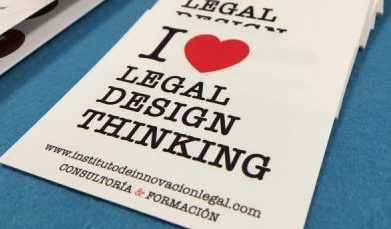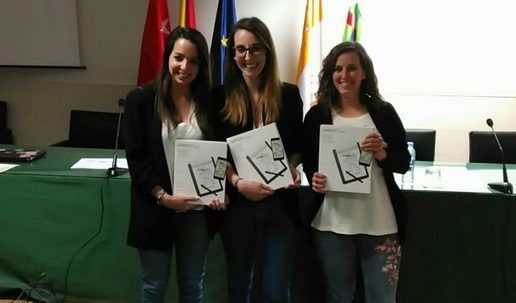
What happened at the Legal Design Challenge?
Chronicle of the 1st Legal Design Challenge #ESLegalDesign
This post is a bit long, so you can use the shortcuts below to go directly to the part that interests you most. You will also find several videos (in Spanish though, sorry…) of the event.
CONTENT
1. What is the Legal Design Challenge?
2. Who attended the Expert Forum on Understandable Law and Transparency?
3. What was discussed at the Expert Forum on Understandable Law and Transparency?
4. Who participated in the workshops?
5. What did the workshops consist of?
6. What exercises did the participants in the workshops do?
7. What did the contest consist of?
8. Awards and winners
9. How was the event publicized?
10. Conclusions
What is the Legal Design Challenge?

The Legal Design Challenge, #EsLegalDesign, is an innovative program that aims to improve the legal experience of clients. Organized by the Instituto de Innovación Legal (IIL) with the sponsorship of Thomson Reuters, the Universidad CEU San Pablo, reclamador.es, Vector and Wacom, it was held on 17 and 18 April 2018 at the Faculty of Economics and Business Studies and at the Faculty of Law of the Universidad CEU San Pablo (Madrid, Spain).
The programme consisted of three parts: a forum of experts in understandable law and transparency, a series of training workshops on Legal Design Thinking and a competition, the «challenge», in which a jury made up of María Jesús Alonso, Vicente Gil, Amalia Iraburu, José Luis Piñar, Daniel Rubio and Rodrigo Tena, chose from among the 8 participating teams, made up of lawyers, marketing, customer experience and compliance managers, who managed to design the best infographics and the most comprehensible contract.
Who attended the Expert Forum on Understandable Law and Transparency?
The Expert Forum on Understandable Law and Transparency with clients was attended by almost 300 people. The audience included lawyers, registrars, notaries, students, professors, academics and marketing, customer experience and compliance managers. All of them with a common goal: to learn about understandable law and transparency in contracts and pre-contracts in order to provide a good legal customer experience (CX).
What was discussed at the Expert Forum on Understandable Law and Transparency?
[embedyt] https://www.youtube.com/watch?v=en-02TEY-ak[/embedyt]
The expert forum was inaugurated by Carlos del Valle, dean of the Universidad CEU San Pablo, and José María Alonso, dean of the Madrid Bar Association. Subsequently, María Jesús González-Espejo (ILL) gave a presentation on the role of legal professionals and the law in the customer experience, in which she stressed that jurists must «take up the advantages offered by technology to generate better experiences in legal relations and take profit of methodologies such as Legal Design Thinking to design legal documents that can satisfy the customer’s needs, because the customer is no longer as before. If he wants to, he has powerful tools at his fingertips, especially those that can damage corporate reputation.»
Carlos Pérez del Valle, Dean of the Faculty of Law at CEU San Pablo, and José María Alonso, Dean of the Madrid Bar Association
Ángel Sánchez Aristi, FIFED Strategy Director and Founding Partner of Dictum Futurae, and María José Huertas, Manager of Technological and Emerging Business, General Legal Department, Repsol.
Anxo López González (BBVA bank) also took part in the Experts’ Forum, who talked about his company’s Design Thinking project. Jaime Barbero (Thomson Reuters) presented the Contract Express technology to manage the contracting process of companies and Pablo Rabanal (reclamador.es) explained how his company uses technology in all its processes and its successful business model, which has positioned it as one of the companies with the highest number of lawsuits filed each month before the Spanish courts.
Anxo López González, Lead Design Strategist at BBVA, Jaime Barbero, Value Proposition Manager at Thomson Reuters, and Pablo Rabanal, Director and founder of reclamador.es.
During the panel moderated by Confilegal editor Carlos Berbel, Eugenio Ribón (lawyer), Carlos Ballugera (registrar) and Rodrigo Tena (notary) reviewed the legislation and case law on transparency and understandability.
Carlos Ballugera, Property Registrar, Rodrigo Tena, Notary Public and editor of the Hay Derecho blog, Eugenio Ribón, Lawyer and member of Madrid Bar Association, President of the Association of Consumer Law Practitioners, and Carlos Berbel, Editor of Confilegal.
Finally, Sara García (Legálitas), María Belén Pose (Arag) and Esperanza Medrano (UNESPA, Spanish Insurance Business Association) spoke about the industry’s vision in this area and presented policies and concrete solutions to meet the needs of clients in legal relations with companies.
Sara García, Lawyer of Legálitas, and María Belén Pose Vidal, Lawyer, Director of the Corporate Legal Department ARAG SE, branch in Spain and member of the Traffic Law section of the Barcelona Bar Association.
Who participated in the workshops?

A total of 24 people participated in the workshops and in the subsequent Challenge, divided into 8 teams of 3 professionals:
- The ARAG team.
- The DAS Seguros team.
- The Vector team.
- The BBVA Seguros team.
Apart from these 4 corporate teams, 4 other teams were formed with the professionals who had signed up individually, some of whom had applied for and earned a grant.
What did the workshops consist of?
[embedyt] https://www.youtube.com/watch?v=ABJBbtIUPaY[/embedyt]
Two 5-hour workshops were held, each one aimed at training attendees in the disciplines of Design Thinking, Visual Thinking and Legal Design. The objective was to learn in a very tangible way how to improve legal services and documents using Design Thinking techniques and tools. The learning was completely experience-based, so the teams learnt by practicing, listening, talking, designing, playing, writing and drawing.
What exercises did the participants in the workshops do?

Although there is a multitude of legal Design Thinking exercises, only a selection of some of them (14 in total) could be carried out due to the existing time limitation.
For the practical exercises, the afternoon Design Thinking workshop focused on the imaginary assumption that teams were working on improving the user experience at a notary’s office when he or she comes to make his or her will. The participants worked in the role of consultants hired to help the notary to offer their clients a satisfactory experience throughout the «journey» of this service.
At the next morning Legal Design workshop, they worked on the assumption of being lawyers for a New Business Limited Company (Sociedad Limitada Nueva Empresas). In this second training, they used the Contract Canvas template – an IIL original creation – to help lawyers use the Design Thinking process to identify key elements to design contracts in a different way, focusing on the needs and insights of the client.
What did the contest consist of?
[embedyt] https://www.youtube.com/watch?v=6xzpsZicco0[/embedyt]
A total of 8 teams, each made up of three people, were competing on the same document, the template provided by the Spanish Data Protection Agency for the contract of data processor, which they had to convert into a understandable, transparent and accessible document, and also into an explanatory infographic of the process and the necessary steps. All this, of course, using the techniques learnt in the workshops and the tools provided by the teachers.
For two and a half hours, all the teams worked very hard. They were assisted by a panel of consumers, whom they could consult, and with whom they could test their contracts and documents.
Each team then presented their work to the jury, showing the different items requested for the competition: the Contract Canvas, the contract and the infographics supporting it.
Awards and winners
 Some lively discussions followed the tight scores of the teams, but the jury finally decided to give the award to the team formed by Esther Bueno Benito, Mª del Carmen Ortega Arasco and Marta Chaso García, from the Vector team, all of them professionals assigned to the Technical Office of the Ministry of Justice.
Some lively discussions followed the tight scores of the teams, but the jury finally decided to give the award to the team formed by Esther Bueno Benito, Mª del Carmen Ortega Arasco and Marta Chaso García, from the Vector team, all of them professionals assigned to the Technical Office of the Ministry of Justice.
Ortega Arasco finally commented: «I really liked the experience at LDC, I learnt a lot about Legal Design and it has been very dynamic, undoubtedly an experience to be repeated».
How was the event publicized?

The Expert Forum on Understandable Law and Transparency was streamed through Youtube. Also through social networks, such as Facebook and Twitter, where there was continuous interactions during the Forum, the workshops and finally, the Challenge. The Legal Design Challenge was actually a national Trending Topic with its hashtag #ESLegalDesign.
Conclusions

The 2-day Legal Design Challenge has provided an overview on a discipline that is begging for a step forward: the Legal Customer Experience (Legal CX). It is a science where Understandable Law and Transparency converge with the best marketing and communication practices. It places the client, the consumer, the user, at the heart of the legal relations between them and companies and organizations of any kind, whether public or private.
There is methodology, essentially Legal Design Thinking + LegalTech, allowing any company to generate good experiences in this field. A lawyer has a duty to know and use them, because the reputation of his or her company or organization is at stake. It is now possible and necessary to provide satisfactory experiences in the legal field and all the signs can be found around us: legislation, case law, and above all, clients’ voices, invite us to think that there is no time to lose!





